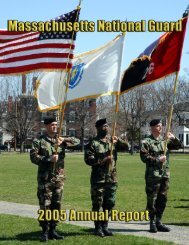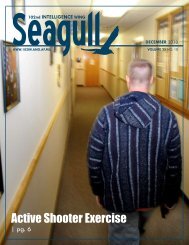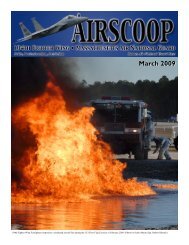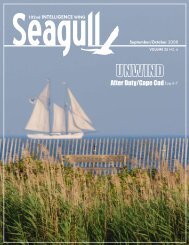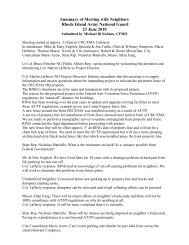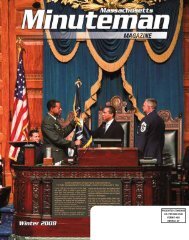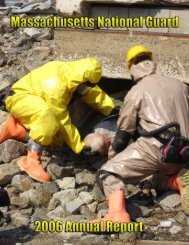MMR Alternative Energy Planning Policy - STATES
MMR Alternative Energy Planning Policy - STATES
MMR Alternative Energy Planning Policy - STATES
Create successful ePaper yourself
Turn your PDF publications into a flip-book with our unique Google optimized e-Paper software.
.,<br />
Massachusetts Military Reservation<br />
Joint Oversight Group<br />
- --<br />
Massachusetts Military Reservation (<strong>MMR</strong>) Joint Oversight Group (JOG)<br />
<strong>MMR</strong> <strong>Alternative</strong> <strong>Energy</strong> <strong>Planning</strong> <strong>Policy</strong> - <strong>Policy</strong> Letter #1<br />
16 April 2008<br />
1. Reference: Memorandumof Understanding(MOU) Concerningthe MassachusettsMilitary Reservation<br />
InstallationPartnershipJoint InstallationManagementAgreement,21 Jun 07.<br />
2. Purpose: <strong>Alternative</strong> energy initiatives are encouraged to reduce the <strong>MMR</strong>'s commercial energy dependency.<br />
The <strong>MMR</strong>'s uniqueness as the largest military training area in New England and also being designated as the<br />
Upper Cape Water Supply Reserve must be taken into consideration to ensure neither is compromised when<br />
developing alternative energy sources. Due to the environmental and operational constraints at the <strong>MMR</strong>, it is<br />
necessary to have a joint alternative energy planning policy to serve as a guideline to address alternative energy<br />
systems proposed by the individual commands/organizations at <strong>MMR</strong>. This policy letter addresses geographical<br />
considerations, site location considerations, and the process for <strong>MMR</strong> organizations to use to apply for approval<br />
to install alternative energy facilities.<br />
3. <strong>Alternative</strong> <strong>Energy</strong> Sources: Due to the size and location of the <strong>MMR</strong>, two main primary alternative energy<br />
concepts are viable for consideration: solar power and wind power generation. Other alternative energy concepts<br />
that may also be viable will be subject to this policy. The use of photovoltaic cells in solar panels for energy<br />
generation is an efficient alternative if there is sufficient space available for the installation of solar panels.<br />
Advances in solar photovoltaic technology are occuning rapidly and new initiatives could be an effective<br />
alterative at the <strong>MMR</strong>. Photovoltaic or heat generating solar thermal panels for small-scale applications requiring<br />
minimal space could be sited virtually anywhere at the <strong>MMR</strong> where the installation does not adversely impact<br />
training or the environment. Large-scale solar panel systems need to be assessed on a case-by-case basis. Wind<br />
turbines ~ another primary alternative energy solution for consideration. Much of this policy letter will focus on<br />
considerations that need to be reviewed before approving a site as appropriate for an alternative energy purpose,<br />
and in particular for wind turbines. Wind turbine site selection is predominantly related to the height and<br />
structural size of the individual unit. For the purposes of this document, three sizes of wind power turbines are<br />
considered: Large size, utility-grade wind turbines in excess of 150 feet in total height; medium size, 50 to 150<br />
feet in height; and, small size, less than 50 feet in height, to include rooftop mounted units. While not a new<br />
initiative, conservation of energy resources is a highly effective way to reduce energy costs.<br />
4. Site Suitability: The purpose of this policy is to not take into account each and every detail that would go<br />
into the site selection phase for renewable energy generation initiatives. It is more the purpose to give general<br />
guidance for those considering renewable energy facilities. Appendix A provides areas of consideration when<br />
developing an alternative energy proposal.<br />
s. Approval for 'enewable <strong>Energy</strong> Initiatives: APPENDIX A provides geographic and operational<br />
considerations an orghnization must consider when developing its proposal. If an organization desires to pursue<br />
the installation of an alternative energy source at the <strong>MMR</strong>, it will complete the information requested in<br />
APPENDIX B, Information Desired Regarding Renewable <strong>Energy</strong> Initiatives For <strong>MMR</strong> Review. APPENDIX C<br />
contains information that must be coordinated with the 6thSpace and Warning Squadron to ensure a wind energy<br />
proposal meets their criteria for determining any impact to Pave PAWS radar operations, to include a diagram of<br />
where the turbine will be in reference to the radar. Submit the required information to the E&RC National Guard<br />
Planner, Mr. Nickerson (508-968-5153). He, in turn, will review the application and coordinate any additional<br />
information from the organization, as necessary. The E&RC will provide the full application package to the<br />
<strong>MMR</strong> <strong>Energy</strong> Committee for review and analysis. Once completed, the <strong>Energy</strong> Committee will forward the<br />
package and provide a recommendation to the Joint Oversight Group (JOG) Chairman. The JOG (the Camp<br />
Edwards Commander must coordinate the MA ARNG response with JFHQ for input to the JOG) will provide the<br />
proponent with an approval/disapproval decision. For a proposal to move forward, the JOG decision must
Massachusetts Military Reservatiou<br />
Joint Oversight Group<br />
16 April 2008<br />
unanimously approve the decision in order to fully protect the environmental and operational aspects of the<br />
<strong>MMR</strong>. The responsibility of infonning or applying to regulatory agencies will remain with the proponent.<br />
6. Officeof Primary Responsibility(OPR)<br />
6.1. The Joint Oversight Group (JOG) is the detennining body for the development and implementation of joint<br />
organizational policies impacting all <strong>MMR</strong> organizations, per the referenced MOU.<br />
6.2. The MANG's Environmental & Readiness Center is the OPR for the policy documents and charged with the<br />
responsibility to maintain, distribute (on behalf of the JOG), and keep current this policy letter.<br />
~.~v'W<br />
(jxecutive Off!ce of Public Safety and Security<br />
JOG Representative<br />
DISTRIBUTION:<br />
Joint Force Headquarters: CoS - Anny/Air, CFMO, 13,J4<br />
Camp Edwards, Commander<br />
102 Fighter Wing, Commander<br />
USCG Air Station Cape Cod, Commander<br />
6th Space Warning Squadron, Commander<br />
Installation Restoration Program, Program Manager<br />
Impact Area Groundwater Study Program, Program Manager<br />
Department of Agriculture, Director<br />
Department of Veterans Affairs, National Cemetery, Director<br />
Barnstable County Sherriff<br />
Environmental Management Commission, Environmental Officer<br />
JFHQ - CFMO<br />
253 CCG/CC<br />
267 CBCS/CC<br />
ERC - DR<br />
t-- I{o/w.eI, V~AP<br />
Commander, 6th Space Warning Squadron
Massachusetts Military Reservation<br />
Joint Oversight Group<br />
APPENDIX A<br />
1. Considerations for locating alternative energy initiatives:<br />
16 April 2008<br />
1.1. Wind <strong>Energy</strong>. Cape Cod is one of the better land areas in Massachusetts for wind power generation due to<br />
its close proximity to the ocean and lack of geographical terrain obstacles. Using web-based analytical sites to<br />
detennine median wind strength at <strong>MMR</strong>, the wind velocities generally range between 6.5 and slightly over 7 m/s<br />
for wind turbines at 80 meters above ground level. The mean speed of the wind (Figures 1) is an obvious<br />
consideration when planning for a location for a wind turbine.<br />
1.2. Proximity to the <strong>MMR</strong> electrical grid connections: While locating a renewable energy source near any<br />
electrical grid is an overall benefit to the region, having it near the <strong>MMR</strong> electrical grid adds a greater benefit to<br />
the military and other organizations at <strong>MMR</strong>. An approximation of the <strong>MMR</strong> grid coverage is shown in Figure<br />
2. Renewable alternative energy generators connected to the <strong>MMR</strong> grid provides for greater energy independence<br />
for <strong>MMR</strong>. If these sources are connected to the NSTAR grid outside <strong>MMR</strong>, <strong>MMR</strong> will still be dependent on the<br />
NSTAR grid for energy and the goal of greater energy independence is not met.<br />
1.3. Ease of access for construction and maintenance - Locating renewable energy facilities in close proximity<br />
to existing roads and access points reduces the costs of construction and maintenance. Furthermore, having to<br />
extend roadways through undeveloped areas may damage natural resources and habitat.<br />
1.4 Airfield Safety Zones - These are the zones extending out from both ends of each runway and depicted in<br />
Figure 3. Airfield safety zones are standard for all large airfields, both military and civilian. Placing large<br />
renewable energy facilities in these zones should be prohibited. Smaller-scale wind or solar power generators<br />
may be sited in the airfield safety zones, but each initiative should be evaluated as to its impact on aviation safety.<br />
1.5. Army Aviation Low Altitude Flight Training Areas - As shown in Figure 4, there are large areas of the<br />
northern 15000 acres of<strong>MMR</strong> where Army Aviation rotary wing aircraft train for low level flight. Placing large<br />
renewable energy facilities in these zones should be prohibited. Smaller-scale wind or solar power generators<br />
may be sited in Army Aviation training areas, but each initiative should be evaluated as to its impact on aviation<br />
safety and impact on training.<br />
1.6. Military training - Maneuver and Land Navigationareas - In addition to the firing ranges in the northern<br />
portion of <strong>MMR</strong>, the northern training area of Camp Edwards is an important land area for military maneuvering<br />
and land navigation training. See Figure 5. Placing large, renewable energy wind turbines in these areas would<br />
provide easily identifiable landmarks that could degrade the ability to train soldiers in these skills. As these<br />
maneuver and land navigation areas are almost one in the same as where Army Aviation units practice low level<br />
flying, it would be detrimental to soldier training for large structures to be located in these areas.<br />
1.7. Emergency Aviation Routes - The USCG Search and Rescue Emergency Corridors are routes used by<br />
USCG Air Station Cape Cod during inclement weather when responding to emergencies at sea. See Figure 6.<br />
When responding to emergencies in bad weather, USCG aviators fly low along these corridors so that they have<br />
both instrument navigation as well as visual landmarks to plot their course to and from the shoreline. Placing<br />
renewable energy facilities greater than 100 feet above ground level in these corridors should be prohibited.<br />
Smaller-scale wind or solar power generators may be sited in these emergency corridors, but each initiative<br />
shouldbe evaluatedas to its impactonaviationsafety. .<br />
1.8. Pave PAWS Electromagnetic Interference - Wind turbines have the potential of degrading radar<br />
performance at the Cape Cod Air Force Station 6th Space Waming Squadron's Pave PAWS if the wind towers are<br />
in the way of the radar beam or if the frequency of the turbine is in conflict with the frequency of the radar.
Massachusetts Military Reservation<br />
Joint Oversight Group<br />
16 April 2008<br />
1.8.1. The Pave PAWS radar searches an area horizontal to the earth from an azimuth of 341> to 221> True.<br />
Vertically, the beam rises 3° from horizontal to 85° within those azimuths. Therefore, any tall structure that is<br />
within these envelopes of space might impact the mission of Pave PAWS. In the spring of 2007, the DOD<br />
Missile Defense Agency (MDA) produced a report stating that "...utility class wind farms could have a<br />
significant impact on radars ..."(referring to Pave PAWS) and that "... To mitigate this impact, (DOD should)<br />
establish and enforce a wind farm offset zone within the effective 'line-of-sight' of the radars, taking into account<br />
the direct, refIacted, and diffracted signals from the radar. This effectively establishes a zone around the radar of<br />
approximately twenty-five (25) kilometers, assuming relative terrain."<br />
1.8.2. Individual wind turbine proposals should be analyzed with regard to impact on Pave PAWS radar. Within<br />
the horizontal range of beam sweep, 25 kilometers encompasses all of <strong>MMR</strong> and south beyond the Falmouth<br />
shoreline. All wind turbine proposals must be submitted to the 6 SWS who in turn will forward to Air Force<br />
Space Command (AFSPC) for approval or disapproval. As a courtesy all wind turbine packages will be<br />
forwarded to MDA by AFSPC for approval or disapproval. Approval ftom AFSPC and MDA are required to<br />
build wind turbines within 25 kIn of the Pave PAWS radar. Figure 7 depicts the azimuths of the Pave PAWS<br />
radar beam.<br />
1.9. Electromagnetic interference with airfield operations, radar or base communications - Any major<br />
airfield or military installation has a wide variety of communications devices and radar used for a multitude of<br />
purposes. Each renewable energy initiative should be evaluated as to its impact on all <strong>MMR</strong> electronic integrity.<br />
1.10. Environmentally sensitive areas where wind structures would significantly degrade habitat or<br />
groundwater - <strong>MMR</strong> is an important natural resource not only for habitat but also as the source of much of Cape<br />
Cod's water supply. Accordingly, each renewable energy initiative should be evaluated as to its impact on<br />
<strong>MMR</strong>'s natural resources. Wetlands, the most sensitive areas at <strong>MMR</strong>, are depicted in Figure 8.<br />
1.11. Groundwater weD-headzonesfor large wind generating systems- Generally, any kind of development<br />
is discouraged in drinking-water well-head areas. For the most part, the discouragement pertains to the level of<br />
activity for developed use after construction, although the impact of construction itself is part of the concern.<br />
Small-scale renewable energy improvements in well-head zones will be considered, particularly if the renewable<br />
energy sources are being utilized to power the well itself. Larger scale renewable energy facilities will need to be<br />
assessed as to their impact on the quality of the groundwater at the well head. Figure 9 identifies the drinking<br />
water wells at <strong>MMR</strong>.<br />
1.12. Close proximity to military housing by larger systems that could create nuisance - In addition to the<br />
visual impact of a large wind turbine, wind power generating facilities may have noise impacts - real or<br />
perceived. In general, it is prudent to site large energy facilities away ftom dense housing areas. Figure 10 shows<br />
the area of USCG housing at <strong>MMR</strong>.<br />
2. Based on the location considerations outlined in the previous sections, it is possible to identify general areas<br />
where renewable energy facilities might be considered and areas that should be off-limits to large renewable<br />
energy facilities such as utility-grade wind turbines. As far as geographic criteria that favor the siting of<br />
renewable energy facilities, there are two - the <strong>MMR</strong> electrical grid and the highest wind velocities. Figure 11<br />
places these areas on one map of <strong>MMR</strong> and, unfortunately, the base grid is not coexistent with the greatest wind<br />
velocities on the <strong>MMR</strong> property.<br />
2.1. With regard to criteria that would argue against large renewable energy facilities, particularly large wind<br />
turbines, there are more overlapping geographic factors, predominantly related to aviation operations, Pave<br />
PAWS radar, military training and environmental protection. These are depicted in Figure 12.
Massachusetts Military Reservation<br />
Joint Oversight Group<br />
16 April 2008<br />
2.2. By taking the graphic depicting favorable areas for renewable (wind) energy location and comparing it with<br />
the graphic that show areas where renewable (wind) energy may be discouraged, three areas of <strong>MMR</strong> stand out<br />
for having favorable conditions and no unfavorable conditions. Two are in the Cantonment Area and served by<br />
the <strong>MMR</strong> electrical grid. One is on the southwest portion of the Cantonment Area south of Connery Avenue and<br />
west of the Otis ANGB runway. The other is the area where the Unit Training Equipment Site (UTES) and the<br />
former BOMARC missile site are located. This is on the eastern boundary of <strong>MMR</strong> directly north of the airfield.<br />
A third area is in the vicinity of the USCG antenna station at the northeastern portion of the Camp Edwards<br />
Training Site and adjacent to Massachusetts Route 130. While this area is not served by the <strong>MMR</strong> electrical grid,<br />
the wind velocities in this area are stronger and the area is not used for military training because of the antenna<br />
arrays. There is a fourth, rather small area on the southeastern comer of <strong>MMR</strong> on land owned by the US Air<br />
Force that is also connected to the <strong>MMR</strong> base electrical grid that might also be considered for some limited<br />
renewable energy generation.<br />
2.2.1. Smaller renewable energy units may be located in other areas of <strong>MMR</strong>. Roof top units on buildings have<br />
little or no impact on military operations and training. Small and medium sized wind turbines might be placed on<br />
selected areas of Greenway Road. Along Gibbs Road, there is a large electrical transmission line. The support<br />
towers range in height from about 85 feet to 112 feet. Small wind turbines at or below the height of the support<br />
towers may be feasible along Gibbs Road.<br />
6.1 6<br />
t<br />
-~<br />
1<br />
.86.8// ,.-/<br />
I 7\ -<br />
. / /' ~1<br />
Z(~ \~<br />
!oo J ~\<br />
.. '\'.-<br />
--l~'<br />
"'<br />
I<br />
Figure 1 Figure 2<br />
/<br />
'/<br />
.~.l,.<br />
;..it<br />
:->~- -,..' .~"~::.,...,<br />
/ ' ::--,,1,( '.r-h"'i/' .<br />
. ,<br />
-1. , 0-~.~<br />
~..."<br />
t<br />
"rid : " /1<br />
'<br />
j'/ \/ ~<br />
,. , ''"''\, .<br />
t./ / \ ~<br />
..1.<br />
....-
Massachusetts Military Reservation<br />
Joint Oversight Group<br />
Figure 3<br />
Figure 5<br />
- ~-:~:.",.
Massachusetts Military Reservation<br />
Joint Oversight Group<br />
'3-}<br />
:) /<br />
'\
Massachusetts Military Reservation<br />
Joint Oversight Group<br />
OverliIY of Best Wlnd1ll1d.Base<br />
ElecltICaIGrtd as Feat"'S<br />
Favp~,Wlnd I:'oweratNNR<br />
) /<br />
'"<br />
16 April 2008
.<br />
'"<br />
Massachusetts Military Reservation<br />
Joint Oversight Group<br />
APPENDIX B<br />
Information Desired Regarding Renewable <strong>Energy</strong> Initiatives For <strong>MMR</strong> Review Process<br />
Photovoltaic System (PV) Information<br />
PV Module Manufacturer:<br />
Module Model Nwnber:<br />
Nwnber of Modules:<br />
Power Rating per Module:<br />
DC Watts<br />
Total Array Output: DC Watts (no. of modules x power rating)<br />
System Rated Output: AC Watts (total array output x .95)<br />
Inverter Manufacture:<br />
Inverter Model Nwnber:<br />
Inverter's Continuous AC Rating:<br />
AC Watts<br />
Physical Size of Installation: Total Height ; Total Length<br />
Total Width ; Total Weight after Installation<br />
Describe the physical location of the installation and/or mounting structure:<br />
Describe the physical location of the facility's lockable disconnect switch:<br />
Describe Physical Access Requirements for Construction and Subsequent Maintenance:<br />
State whether you are installing your PV system on (answer yes or no): an existing structure_<br />
Wind System Information<br />
Wind Turbine Manufacturer:<br />
Turbine Model Nwnber:<br />
Wind Turbine Power Output: Watts; (peak output up to 30mph wind speed)<br />
AC Source (circle one):<br />
Inverter Synchronous Generator Induction Generator<br />
Physical Size of Installation: Total Height of Mast ; Radius of Propeller<br />
Propeller ttom Ground Level ; Size of Foundation, Depth , Width<br />
Total Weight after Installation<br />
16 April 2008<br />
; Total Height to Top of<br />
, Length
Massachusetts Military Reservation<br />
Joint Oversight Group<br />
Describe the physical location of the installation and/or mounting structure:<br />
Describe the physical location of the facility's lockable disconnect switch<br />
Describe Physical Access Requirements for Construction and Subsequent Maintenance:<br />
If using an inverter, complete the following:<br />
Inverter Manufacturer:<br />
Inverter Model Number:<br />
Inverter's Continuous AC Rating: AC Watts<br />
System Rated Output: AC Watts; (wind turbine power output x .95)<br />
16 April 2008
Massachusetts Military Reservation<br />
Joint Oversight Group<br />
APPENDIX C<br />
6th Space Warning Squadron<br />
Wind Turbine Template<br />
Current Data:<br />
Pave PAWS latitude: 410 45' 08.844N<br />
PavePAWS longitude: 700 32' 17.228W<br />
Pave PAWS height above sea level at roof: 82.9m (Source: WGS84)<br />
Pave PAWS building height 104 ft 4 718 in. (Source: Site Drawings)<br />
Requested Data:<br />
Turbine latitude:<br />
Turbine longitude:<br />
Turbine height above sea level at ground:<br />
Turbine max height above ground wi blade vertical:<br />
Requesting organization:<br />
Point of contact:<br />
Projected dates of construction:<br />
What the tower structure is made of:<br />
What the tower is covered with (i.e. fiberglass):<br />
Whether or not the tower is tapered:<br />
Azimuth off the nearest bore sight (TBD by 6 SWS personnel):<br />
Diagram of proposed turbine<br />
near Cape Cod Air Force Station<br />
Face B<br />
Bore Sight -470<br />
FaceA<br />
Bore Sight - 1670<br />
Proposed Turbine<br />
Azimuth off<br />
bore sight<br />
16 April 2008<br />
..11<br />
I'ollf,c SPA(,f- ((11I\
..'




